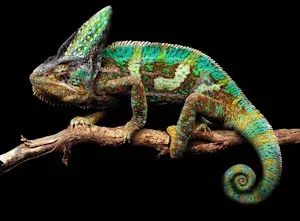Introduction: Fascinating Inhabitants of the Terrarium
The Yemen chameleon (Chamaeleo calyptratus) is one of the most popular chameleons in terrarium keeping. Its impressive size, vibrant colors, and distinctive casque structure make it a remarkable eye-catcher. However, keeping these animals requires a fundamental understanding of their needs. In this article, you’ll learn everything about proper care, the ideal terrarium setup, and the right diet for Yemen chameleons.
1. Yemen Chameleon: Origin and Lifestyle
Origin
The Yemen chameleon originates from the mountainous regions of Yemen and Saudi Arabia. It inhabits dry, semi-humid areas and is well-adapted to extreme climates.
Lifestyle
- Diurnal: Yemen chameleons are active during the day and spend much of their time on branches.
- Solitary: These chameleons are territorial and should be kept alone.
- Movement: They move slowly and deliberately to remain unnoticed.
Special Features
- Sexual Dimorphism: Males are larger and more colorful than females.
- Size: Males can grow up to 60 cm, while females are smaller, measuring about 35–45 cm.
2. The Right Terrarium for Yemen Chameleons
Terrarium Size
- Male Only: Minimum size of 100 x 50 x 120 cm (L x W x H).
- Females or Juveniles: Slightly smaller terrariums can suffice, but the height must always be sufficient.
Setup
- Climbing Structures:
- Branches and twigs of varying thickness and height.
- Horizontal and vertical climbing opportunities.
- Plants:
- Real plants like Ficus, Schefflera, or Pothos provide hiding spots and humidity.
- Artificial plants can be used as supplements.
- Substrate:
- Coconut fibers, non-fertilized potting soil, or sand-soil mixtures are ideal.
- Hiding spots: Dense plant areas or retreat spaces offer protection from stress.
Lighting and Temperature
- UVB Lighting: Essential for Vitamin D3 synthesis and healthy bones. Use special UVB bulbs.
- Daylight Bulbs: Provide bright lighting for 12 hours a day.
- Heat Spots: Local temperatures of 35–40 °C directly under the lamp.
- Terrarium Temperature: 25–30 °C during the day, cooling to 18–22 °C at night.
Humidity
- Optimal Range: 50–70%.
- Regular Spraying: Mist plants 2–3 times daily. Automatic misting systems are a worthwhile investment.
3. Diet: What Does a Yemen Chameleon Eat?
Main Diet
Yemen chameleons are insectivores and enjoy the following food items:
- Crickets, grasshoppers, house crickets.
- Cockroaches, waxworms, and Zophobas (only occasionally, as they are fat-rich).
Green Food as Supplement
- Females and juveniles often accept green food such as:
- Dandelion, endive, cucumber, carrot.
Supplementing Insects
- Calcium and Vitamins: Dust insects with special supplements.
- Feeding Insects: Provide insects with fruits and vegetables before feeding them to the chameleons.
Feeding Schedule
- Juveniles: Feed 2–3 times daily.
- Adults: Feed every 2 days.
Water Intake
Yemen chameleons drink droplets from leaves. Use misted water or a drip system.
4. Care and Health Maintenance
Regular Cleaning
- Daily: Remove droppings and food leftovers.
- Thorough Cleaning: Clean the terrarium and replace the substrate every few months.
Recognizing Health Issues
- Signs of Illness:
- Lethargy, loss of appetite, or weight loss.
- Deformities in the tail or legs (indicating calcium deficiency).
- Changes in skin color or open wounds.
- Common Diseases:
- Rickets: Caused by calcium or Vitamin D3 deficiency.
- Parasites: Mites or worms.
- Dehydration: Due to insufficient humidity.
Regular Vet Visits
Consult a reptile-savvy vet at the first sign of problems.
5. Behavior and Handling of Yemen Chameleons
Observation Instead of Handling
Yemen chameleons are observational animals and should be handled only rarely and gently to avoid stress.
Understanding Behaviors
- Color Change: Used for communication, temperature regulation, or as a stress signal.
- Territorial Behavior: Males defend their territory vigorously.
6. Breeding Yemen Chameleons
Mating
Females should only be bred at the age of 12–18 months. Only introduce males and females for short periods.
Egg Laying
Females lay 20–50 eggs in moist soil. Provide a laying box with loose soil.
Incubation
Eggs are incubated at 26–28 °C. The incubation period lasts 6–9 months.
Raising Juveniles
Juveniles require smaller terrariums and are fed small insects like fruit flies.
7. Legal Aspects and Costs
Species Protection
Yemen chameleons are not protected, but it is important to choose a reputable breeder.
Cost Overview
- Acquisition: 50–150 € per animal, depending on age and sex.
- Terrarium and Accessories: 300–600 €.
- Ongoing Costs: Food, electricity for lighting, and heating.
Conclusion: Proper Care is Worth It
Yemen chameleons are fascinating terrarium animals, but they require demanding care and a well-set-up terrarium. With the right care, you can keep these impressive animals healthy and happy for many years. Their vibrant colors and unique behavior make them a highlight in terrarium keeping.

